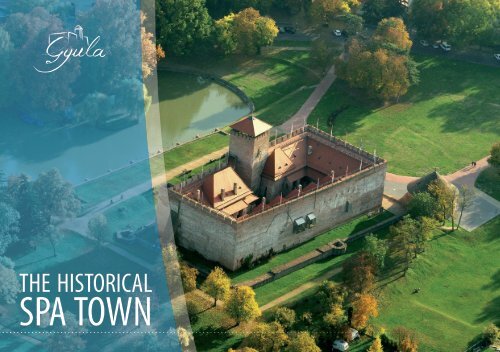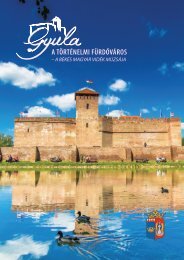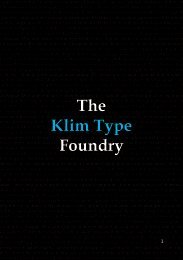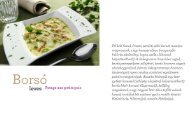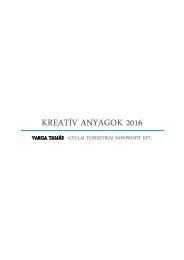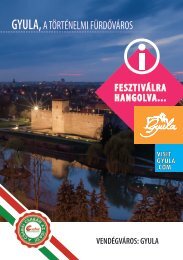Gyula, the historical spa town
www.VISITGYULA.com
www.VISITGYULA.com
You also want an ePaper? Increase the reach of your titles
YUMPU automatically turns print PDFs into web optimized ePapers that Google loves.
THE HISTORICAL<br />
SPA TOWN
Location<br />
<strong>Gyula</strong> lies in sou<strong>the</strong>ast Hungary,<br />
along <strong>the</strong> Romanian border, in<br />
<strong>the</strong> South Great Plain. The climate<br />
is continental with pretty<br />
cold winter and hot summer.<br />
The annual amount of precipitation<br />
is 550-600 mm.<br />
The annual number of<br />
sunny hours is also high in<br />
national terms.<br />
Total population:<br />
31,800 inhabitants<br />
Population density:<br />
124.32 per km2<br />
Area: 255.6 km2
The region of<br />
Körös-Rivers<br />
<strong>Gyula</strong> was built not far from <strong>the</strong><br />
junction of Fekete- and Fehér-<br />
Körös (Black and White Cris)<br />
rivers, on <strong>the</strong> left bank of <strong>the</strong><br />
latter, in a wonderful area,<br />
which has been declared a<br />
national park in part and was<br />
inhabited already in prehistoric<br />
age.<br />
We have 33 locally protected<br />
natural areas and elements<br />
and 215 unique landscape<br />
values. The riverbanks provide<br />
a great location for<br />
those, who are attracted by<br />
<strong>the</strong> undisturbed, peaceful<br />
nature out of <strong>the</strong> <strong>town</strong>.
The Fehér-Körös (White Cris) and<br />
<strong>the</strong> Fekete-Körös (Black Cris) belong<br />
to <strong>the</strong> rivers of <strong>the</strong> cleanest<br />
water in Europe. Along <strong>the</strong>se<br />
rivers, we meet two popular<br />
holiday centres: Szanazug at<br />
<strong>the</strong>ir junction within easy<br />
reach even by bicycle and<br />
Városerdő going upwards<br />
along <strong>the</strong> Fekete-Körös.
The Beginnings<br />
The life-giving water attracted<br />
<strong>the</strong> first settlers to this area. Later<br />
on, also <strong>the</strong> street structure of<br />
<strong>the</strong> settlement, which has 32<br />
thousand inhabitants now,<br />
was formed based on <strong>the</strong> onetime<br />
water system. Reeds,<br />
marshes, meadows and gallery<br />
forests dominated over<br />
<strong>the</strong> landscape. Wetlands with<br />
lush vegetation and rich fauna<br />
determined <strong>the</strong> view.
The look of <strong>the</strong> <strong>town</strong> is determined<br />
by its surface waters:<br />
Fehér-Körös (White Cris) separating<br />
<strong>Gyula</strong> from <strong>Gyula</strong>vári,<br />
Élővíz-csatorna (Live-water<br />
Canal) connecting three settlements<br />
and string of lakes /<br />
ponds surrounding <strong>the</strong> <strong>town</strong>.<br />
The first people appeared<br />
along <strong>the</strong> Fehér-Körös on <strong>the</strong><br />
higher, flood free areas at <strong>the</strong><br />
time of <strong>the</strong> Neolithic age.<br />
The name of Körös-culture<br />
refers to it. Artefacts from<br />
<strong>the</strong> copper, bronze and iron<br />
ages prove <strong>the</strong> existence of<br />
former settlements.
History:<br />
The medieval <strong>town</strong><br />
In 1332, <strong>the</strong> settlement was<br />
mentioned already with <strong>the</strong><br />
name of <strong>Gyula</strong> in <strong>the</strong> chronicle.<br />
<strong>Gyula</strong> began to develop into a<br />
<strong>town</strong> in <strong>the</strong> period of <strong>the</strong> Anjou<br />
Kings. The construction<br />
of <strong>the</strong> fortress started in<br />
1405. The holders of <strong>the</strong> fort<br />
were king and <strong>the</strong> members<br />
of royal families. The pre-<br />
Ottoman <strong>Gyula</strong> was in its<br />
prime at <strong>the</strong> early 16th century.<br />
In 1525, it had already<br />
about 3,000 inhabitants.<br />
After <strong>the</strong> siege of 1566, <strong>the</strong><br />
Ottomans ruled <strong>the</strong> <strong>town</strong><br />
for 129 years.
After <strong>the</strong> ottoman<br />
occupation<br />
The fortress and <strong>the</strong> <strong>town</strong> were<br />
deliberated in January 1695.<br />
By this, it became possible to<br />
repatriate permanently.<br />
The history of <strong>Gyula</strong> after <strong>the</strong><br />
Ottoman rule starts from<br />
1714. The wars partly destroyed<br />
<strong>the</strong> population and<br />
partly drove <strong>the</strong>m away.<br />
The new holder of <strong>the</strong> estate<br />
John George Harruckern<br />
reorganized <strong>the</strong> life in<br />
<strong>the</strong> area.
Multinationality<br />
Romanian and German population<br />
settled in <strong>Gyula</strong> from <strong>the</strong><br />
1720s, which was depopulated<br />
after forcing out <strong>the</strong> Ottomans.<br />
The German settlers brought<br />
such work and industrial culture<br />
with <strong>the</strong>m, which contributed<br />
to <strong>the</strong> embourgeoisement<br />
greatly.
While owing to <strong>the</strong> Romanianspeaking<br />
population, <strong>Gyula</strong> became<br />
<strong>the</strong> centre of Romanian<br />
population in Hungary <strong>the</strong>reby<br />
streng<strong>the</strong>ning <strong>the</strong> tourism<br />
being one of <strong>the</strong> most important<br />
economic sectors of <strong>the</strong><br />
<strong>town</strong>. Town districts, buildings<br />
and churches named after<br />
<strong>the</strong>m keep <strong>the</strong>ir memories<br />
up to now faithfully.
Two Centres of <strong>the</strong> County:<br />
<strong>Gyula</strong> and Békéscsaba<br />
<strong>Gyula</strong> was <strong>the</strong> county <strong>town</strong> of<br />
Békés county for almost 500<br />
years. Though, since 1950,<br />
Békéscsaba has owned this title,<br />
a great part of <strong>the</strong> county<br />
institutions stayed in <strong>Gyula</strong>.<br />
• <strong>Gyula</strong> Regional Court<br />
• Békés County Public Prosecutor’s Office<br />
• Békés County Bar Association<br />
• Pándy Kálmán County Hospital<br />
• The Hungarian National Archives Békés<br />
County Archives<br />
• Körös Valley District Environment and<br />
Water Directorate<br />
• Educational institutions<br />
(primary, secondary and higher)
Great Sons<br />
Ferenc Erkel<br />
The founding fa<strong>the</strong>r of <strong>the</strong><br />
Hungarian national grand opera<br />
and set <strong>the</strong> Hungarian<br />
national an<strong>the</strong>m to music.<br />
György Kohán<br />
The Kossuth Prize-winner<br />
painter of <strong>the</strong> Great Plain.<br />
His name and works are<br />
kept by <strong>the</strong> art gallery in<br />
<strong>the</strong> Göndöcs Park.
Mihály Munkácsy<br />
The world famous painter began<br />
his career within <strong>the</strong> walls<br />
of <strong>the</strong> Almásy Mansion.<br />
Zoltán Bay<br />
One of <strong>the</strong> greatest Hungarian<br />
physicists, whose<br />
name is linked with creating<br />
electron multiplier,<br />
lunar radar and a new definition<br />
of <strong>the</strong> metre.
Agriculture and Food<br />
Industry<br />
Agriculture and food industry<br />
as well as tourism are <strong>the</strong> main<br />
pillars of our economy.<br />
The Körös-Maros (Cris-Mures)<br />
alluvial deposit provides highquality<br />
arable soils, which<br />
create ideal conditions for<br />
cultivation of plants and animal<br />
husbandry based on it.
’<strong>Gyula</strong>i’ sausage<br />
We put <strong>the</strong> launch of <strong>the</strong> meat<br />
trade in <strong>Gyula</strong> to 1868 – <strong>the</strong> first<br />
abattoir of <strong>Gyula</strong> was opened<br />
<strong>the</strong>n.<br />
The <strong>Gyula</strong>hús Kft. is our biggest<br />
food company and one<br />
of <strong>the</strong> biggest meat processing<br />
companies in Hungary.<br />
World famous product:<br />
’<strong>Gyula</strong>i’ sausage
Traditional products<br />
The <strong>Gyula</strong>i Pálinka Manufactory,<br />
which has gained an international<br />
reputation, is <strong>the</strong> worthy<br />
follower of <strong>the</strong> tradition, where<br />
<strong>the</strong>ir distillates are produced<br />
from local fruits.<br />
The handmade bonbons and<br />
chocolates of <strong>the</strong> Cadeau<br />
Bonbon Manufactory are<br />
available also in Budapest in<br />
addition to <strong>Gyula</strong>.<br />
In Békés County a significant<br />
number of beekeepers<br />
work. Their products are<br />
enjoying great popularity<br />
within and outside <strong>the</strong> borders<br />
of <strong>the</strong> country.
Tourism<br />
<strong>Gyula</strong> is <strong>the</strong> fifth most popular<br />
tourist destination in Hungary<br />
for domestic tourists.<br />
The visiting frequency of <strong>the</strong><br />
<strong>town</strong> was increasing in recent<br />
years. In 2014, people visiting<br />
here spent 430,000 overnight<br />
stays in all accommodations<br />
of <strong>Gyula</strong>.<br />
4,800 beds altoge<strong>the</strong>r<br />
ranges from four-star hotels,<br />
through smaller guest<br />
houses to apartment houses<br />
with different categories.<br />
Accomodations with descriptions:<br />
WWW.VISITGYULA.COM
Industry in <strong>Gyula</strong><br />
The FaFém Bútor Zrt. furniture<br />
factory:<br />
Founded in 1950 introduced <strong>the</strong><br />
production of metal frame office<br />
furniture in Hungary.<br />
Dürer Printing House:<br />
Estabilished by Printer István<br />
Nagy P. in 1935. It has been<br />
awarded a number of prestigious<br />
professional recognitions.<br />
Lovász Forgácsoló Kft.:<br />
Our biggest metallurgic<br />
company dealing with metal<br />
cutting, which as a Mitsubishi<br />
Carbide partner manufactures<br />
and sells tool parts,<br />
automotive components<br />
and electronic components<br />
throughout Europe.
<strong>Gyula</strong>i Várfürdő<br />
Situated in <strong>the</strong> 8.5-hectare park<br />
of <strong>the</strong> former Almásy Mansion.<br />
The only five-star rated facility in<br />
lido, water park and <strong>spa</strong> categories<br />
alike in <strong>the</strong> country.<br />
The water of <strong>the</strong> baths has belonged<br />
to <strong>the</strong> healing waters<br />
since 1968 also officially.<br />
The baths obtained a medicinal<br />
baths certification in<br />
1971, while its environs was<br />
certified as a health resort in<br />
1984.<br />
5,000-square-metre facility,<br />
16 pools
The <strong>the</strong>rapeutic section of <strong>the</strong><br />
<strong>Gyula</strong>i Várfürdő was opened to<br />
<strong>the</strong> general public wishing to<br />
recover in August 1968. Still in<br />
<strong>the</strong> same year, head physician<br />
Dr. Margit Aranyosi summarized<br />
her experiences with <strong>the</strong><br />
medicinal bath treatment<br />
of 1678 patients and submitted<br />
it to <strong>the</strong> National Institute<br />
of Public Hygiene.<br />
Where, based on that, <strong>the</strong><br />
water of <strong>Gyula</strong> No. 1 well<br />
was granted healing waters<br />
status. Then, in 1971, <strong>the</strong><br />
Ministry of Health qualified<br />
our baths as a <strong>spa</strong> performing<br />
national duties. In<br />
compliance with <strong>the</strong> applicable<br />
legislation.
AquaPalace<br />
Having enhanced with a new<br />
family water park named Aqua-<br />
Palace, <strong>the</strong> <strong>Gyula</strong> Castle Spa<br />
has become <strong>the</strong> newest, wellequipped,<br />
European standard<br />
lido, <strong>spa</strong> and water park<br />
complex in <strong>the</strong> South Great<br />
Plain, which provides perfect<br />
entertainment, in all seasons,<br />
for <strong>the</strong> visitors of every<br />
generation looking for recreation.<br />
The rightly famous<br />
four-star baths, <strong>the</strong> <strong>Gyula</strong><br />
Castle Spa pampers, relaxes,<br />
exercises and heals.<br />
Slides<br />
• family slide<br />
• “light tunnel” body slide<br />
• “upwards inclining / drop<br />
ping” in-line tube slide
Pools<br />
• Toddler and kiddie pool:<br />
2 water cannons, pirate ship water<br />
slide, 2 animal spouts<br />
• Recreational swimming pool<br />
• Adventure pool:<br />
12 water jet massage benches,<br />
water curtain, lazy river, 2 water<br />
jet massage cabins, 6 neck show<br />
ers, pool floor jets, geysers<br />
• Plunge pool to <strong>the</strong> saunas<br />
• Whirlpool <strong>spa</strong>:<br />
4 water jet massage benches,<br />
8 pool floor jets Diving pool<br />
• Saunas:<br />
• Aroma<strong>the</strong>rapy sauna<br />
• Infrared sauna chamber<br />
• Steam chamber<br />
• Finnish sauna<br />
• Playgrounds<br />
• Pool bar<br />
• Mo<strong>the</strong>r-baby room
The healing Water<br />
The <strong>the</strong>rmal mineral waters contain<br />
various macro elements and<br />
microelements. Due to <strong>the</strong> bathing,<br />
<strong>the</strong> various ingredients of<br />
healing waters get into <strong>the</strong><br />
body through <strong>the</strong> skin, while<br />
o<strong>the</strong>r elements such as sulphur<br />
by means of inhalation.<br />
According to <strong>the</strong> latest water<br />
chemistry tests, <strong>the</strong> water<br />
of Várfürdő No. 1 well contains<br />
2620 mg/l minerals,<br />
and owing to its composition,<br />
it is sodium hydrogen<br />
carbonated <strong>the</strong>rmal water<br />
with a significant metasilicic<br />
acid content. Its temperature<br />
is 69 °C measured at<br />
<strong>the</strong> outflow.
Effects of <strong>the</strong> sodium<br />
hydrogen carbonated<br />
healing waters:<br />
It increases <strong>the</strong> regeneration<br />
capacity of <strong>the</strong> body, has an analgesic<br />
effect, reduces allergic<br />
reactions, has a tranquillizing<br />
on <strong>the</strong> nervous system, reduces<br />
sleep disturbances, reduces<br />
inflammatory processes at an<br />
appropriate temperature, by<br />
inhalation helps coughing<br />
up respiratory secretions as<br />
well as reduces muscle tension.<br />
As a result of bathing,<br />
<strong>the</strong> metasilicic acid is deposited<br />
on <strong>the</strong> skin as a fine<br />
film. The skin feels soapy<br />
and oily, which is especially<br />
useful in case of such<br />
skin diseases as lichen,<br />
psoriasis, eczema and<br />
o<strong>the</strong>r allergic dermatitis.
To whom can be recommended<br />
<strong>the</strong> water cure with <strong>the</strong><br />
healing waters of <strong>Gyula</strong>?<br />
Gynaecological diseases:<br />
• chronic oophoritis<br />
• chronic inflammation of fallopian<br />
tube and ligament<br />
• certain forms of infertility<br />
Urologic diseases:<br />
• chronic cystitis<br />
• chronic prostatitis<br />
Dermatological diseases:<br />
• psoriasis<br />
• seborrhoea<br />
• eczema<br />
• o<strong>the</strong>r chronic dermatitis<br />
Nervous system disorders:<br />
• extrapyramidal movement<br />
disorders, e.g. Parkinson’s<br />
disease<br />
• paralytic syndromes<br />
• chronic neuritises
Musculoskeletal diseases:<br />
• discomforts caused by intervertebral<br />
disc diseases, disc abrasion and disc<br />
herniation<br />
• abrasion of vertebral joints, chronic<br />
low back pain, chronic inflamma tion<br />
of sciatic nerve, cerviobrachi algia<br />
• abrasive disorders of hip, knee and<br />
o<strong>the</strong>r small and large joints<br />
• inactive stage of chronic arthritises<br />
• discomforts caused by osteopo<br />
rosis: chronic back pain, intercos tal<br />
neuralgia<br />
• follow-up treatments of accidents:<br />
aftercare of fractures, liga<br />
ment injuries<br />
• orthopaedic interventions: af<br />
tercare of replacement surgeries,<br />
ligament and cartilage surgeries
Water cure and<br />
complex treatment<br />
Ideally, a water cure lasts 2-3<br />
weeks, 20-30 minutes a day on<br />
1-2 occasions depending on<br />
<strong>the</strong> concomitant illnesses and<br />
<strong>the</strong> actual status of <strong>the</strong> patient.<br />
The bath treatments are<br />
rarely used alone as a mono<strong>the</strong>rapy.<br />
Since a well-made<br />
up, tailor-made complex<br />
treatment is much more efficient<br />
and reduces <strong>the</strong> patient’s<br />
pains in a significant<br />
degree, even in a shorter<br />
period of time and increases<br />
<strong>the</strong>ir muscle strength<br />
and movement functions.
All <strong>spa</strong> visitors have <strong>the</strong> possibility<br />
to make use of specialist<br />
consultations, where <strong>the</strong>y are<br />
not only instructed on <strong>the</strong> use<br />
of <strong>the</strong> baths, but <strong>the</strong> necessary<br />
treatments are prescribed for<br />
<strong>the</strong>m.<br />
Treatments:<br />
• Mud cure<br />
• Weight bath treatment<br />
• Effervescent bath treatment<br />
• Remedial massage treatments<br />
• Underwater jet massage<br />
• Underwater remedial exercises<br />
• O<strong>the</strong>r treatments of remedial<br />
exercises<br />
• Physical <strong>the</strong>rapy
<strong>Gyula</strong> Fortress<br />
The more than 600-year-old<br />
<strong>Gyula</strong> fortress is <strong>the</strong> symbol<br />
of our <strong>town</strong> and <strong>the</strong> same time<br />
its oldest built heritage. This is<br />
<strong>the</strong> only Gothic flatland brickmasonry<br />
fortress in Central-<br />
Europe, which remained intact.<br />
After <strong>the</strong> siege of 1566,<br />
<strong>the</strong> Ottomans ruled it for 129<br />
years.<br />
In <strong>the</strong> museum of <strong>the</strong> restored<br />
fortress opened in<br />
2005, 24 exhibition rooms<br />
present <strong>the</strong> centuries old<br />
history of <strong>the</strong> <strong>town</strong>.
<strong>Gyula</strong> Castle Theatre<br />
The All Arts Festival with <strong>the</strong><br />
Shakespeare Festival of <strong>the</strong><br />
this year 52-year-old <strong>Gyula</strong> Castle<br />
Theatre is <strong>the</strong> most famous<br />
cultural event of our <strong>town</strong>. The<br />
performances can be seen<br />
partly on <strong>the</strong> stage mounted<br />
in <strong>the</strong> courtyard of <strong>the</strong> fortress<br />
and partly on <strong>the</strong> pondstage<br />
constructed over <strong>the</strong><br />
boating pond beside it. The<br />
chamber hall of <strong>the</strong> Castle<br />
Theatre is available also<br />
out of <strong>the</strong> summer season<br />
for <strong>the</strong> visitors appreciating<br />
<strong>the</strong> arts and culture.
Almásy Mansion<br />
After having acquired <strong>the</strong> region,<br />
George Harruckern began <strong>the</strong><br />
construction of <strong>the</strong> mansion.<br />
The restoration of <strong>the</strong> mansion’s<br />
right side-wing, <strong>the</strong> socalled<br />
„vigadószárny” (literally<br />
concert and dance hall wing),<br />
which was emptied in 2002,<br />
was completed in 2004.<br />
The renovation of <strong>the</strong> mansion’s<br />
principal building was<br />
begun in 2013, and in <strong>the</strong><br />
spring of 2016 <strong>the</strong> newest<br />
attraction of our <strong>town</strong>, <strong>the</strong><br />
Almásy Mansion of <strong>Gyula</strong><br />
Visitor Centre will be<br />
opened to <strong>the</strong> public.
In a unique way in Hungary, <strong>the</strong><br />
<strong>the</strong>me of <strong>the</strong> exhibition does not<br />
stop at displaying <strong>the</strong> magnificent<br />
rooms, wall paintings and<br />
<strong>the</strong> family history, but it shows<br />
<strong>the</strong> visitors round <strong>the</strong> world of<br />
aristocrats and <strong>the</strong> hidden<br />
and barely researched areas<br />
of <strong>the</strong> servants’ life.
Erkel Ferenc<br />
Memorial House<br />
The schoolhouse of Németgyula<br />
(German <strong>Gyula</strong>) was built<br />
in 1795. In <strong>the</strong> current form,<br />
Mihály Nuszbek built it by <strong>the</strong><br />
end of 1830.<br />
The Erkel family arrived in<br />
<strong>Gyula</strong> from Pozsony (Bratislava)<br />
in 1806. Ferenc Erkel was<br />
born here on 7 November<br />
1810.<br />
In <strong>the</strong> opening room of <strong>the</strong><br />
exhibition terminals presenting<br />
<strong>the</strong> national an<strong>the</strong>ms<br />
of <strong>the</strong> EU states receive<br />
<strong>the</strong> visitors, and <strong>the</strong>n<br />
<strong>the</strong> hall of European music<br />
follows.
In <strong>the</strong> interactive corner in its<br />
19th century classroom <strong>the</strong>re is a<br />
possibility to solve assignments<br />
of <strong>the</strong> period.<br />
The Erkel memorial room<br />
shows <strong>the</strong> composer’s personal<br />
belongings and relics. The<br />
bedroom, <strong>the</strong> salon and <strong>the</strong><br />
rustic kitchen brings <strong>the</strong> former<br />
home of <strong>the</strong> Erkel family<br />
to mind.
Ladics House<br />
The single-storey <strong>town</strong> house<br />
was built in <strong>the</strong> early 19th century<br />
in Baroque style.<br />
In <strong>the</strong> traditionalist family, <strong>the</strong><br />
furniture, objects and clo<strong>the</strong>s<br />
reflecting <strong>the</strong>ir lifestyle as well<br />
as remembrances showing<br />
<strong>the</strong>ir intellectual life remained<br />
through 5 generations.<br />
The estate of <strong>the</strong> Ladics family<br />
in its kind is a unique <strong>historical</strong><br />
source and document<br />
of <strong>the</strong> life of <strong>the</strong> rural<br />
middle classes in Hungary<br />
in <strong>the</strong> dualistic era and <strong>the</strong><br />
interwar phase. The only<br />
fully furnished witness of<br />
<strong>the</strong> world of <strong>the</strong> middle<br />
classes.
‘Százéves’<br />
Hundred-Year-Old<br />
Confectionery<br />
The second oldest confectionery<br />
of Hungary. It has been<br />
working since 1840.<br />
Within its wonderful building<br />
with empire style, among<br />
<strong>the</strong> ornamentally painted<br />
walls, its original Bieder Meier<br />
furniture and traditional<br />
parfait, sweet and ice cream<br />
offer take <strong>the</strong> visitors back<br />
to <strong>the</strong> one-time bustling<br />
world of coffee houses.
In <strong>the</strong> place of <strong>the</strong> former confectionery<br />
workshop, a confectionery<br />
museum was furnished with<br />
period tools and devices.<br />
In 2004 and 2014, significant<br />
renovations were carried out<br />
on <strong>the</strong> building in order to<br />
maintain it as <strong>the</strong> most valuable<br />
gem of <strong>the</strong> Sou<strong>the</strong>rn<br />
Great Plain.
Göndöcs-kert Park<br />
Benedek Göndöcs proposed in<br />
1884 to create a public garden<br />
on <strong>the</strong> western side of <strong>the</strong><br />
‘Sugár-út’ street (today’s Béke<br />
sugárút). A hall was erected for<br />
<strong>the</strong>atrical performances, social<br />
evenings and dancing<br />
meetings, which was finished<br />
being built in 1889.<br />
Between 1952 and 1975, this<br />
building was <strong>the</strong> community<br />
centre of <strong>the</strong> <strong>town</strong>, and<br />
<strong>the</strong>n, in 1979, <strong>the</strong> Kohán<br />
bequest was placed in it.
The full rehabilitation of<br />
Göndöcs-kert Park was completed<br />
by <strong>the</strong> spring of 2014. The<br />
Kohán Gallery moved to a larger<br />
building, and its former place<br />
serves as a Vigadó (concert<br />
and dance hall) fur<strong>the</strong>r. In <strong>the</strong><br />
event hall restored in its original<br />
splendour many community<br />
programmes serve <strong>the</strong><br />
entertainment of <strong>the</strong> locals<br />
and <strong>the</strong> tourists.
Promenading in <strong>the</strong><br />
Town Centre<br />
The Kossuth square is <strong>the</strong> beating<br />
heart of <strong>Gyula</strong> <strong>town</strong>, which<br />
has become <strong>the</strong> favourite of <strong>the</strong><br />
locals and <strong>the</strong> visitors with its<br />
new appearance. Thanks to its<br />
programmes and events, this<br />
square handling a big traffic<br />
has grown into a new centre.<br />
The World Clock, <strong>the</strong> beauty<br />
of squares, <strong>the</strong> vegetation<br />
of parks and <strong>the</strong> splash of<br />
waters makes complete <strong>the</strong><br />
special atmosphere of <strong>the</strong><br />
<strong>town</strong> centre serving as a<br />
unique background for <strong>the</strong><br />
summer evening milling of<br />
<strong>the</strong> promenade.
In <strong>the</strong> Mood of<br />
Festivals<br />
• Sausage and Gammon Muster of<br />
<strong>Gyula</strong><br />
• International „Kisüsti Pálinka”<br />
Festival, Show and Fair<br />
• Várfürdő Half Marathon and<br />
Relay Race – ’Run for children<br />
with disabilities’<br />
• Sunday of Flowers<br />
• <strong>Gyula</strong> Castle Theatre summer<br />
season<br />
• „Minden Magyarok” International<br />
Folk Dance Festival of<br />
All Hungarians<br />
• Honey and Gingerbread<br />
International Festival of<br />
<strong>Gyula</strong>
<strong>Gyula</strong> <strong>the</strong> Town of<br />
Parks and Flowers<br />
In our <strong>town</strong>, intense and well organized<br />
landscaping and treeplanting<br />
works have been going<br />
on for almost 130 years.<br />
The municipal tree nursery<br />
was founded in 1860.<br />
In <strong>the</strong> period starting from<br />
<strong>the</strong> 1910s, about 21,000<br />
square metres of new park<br />
was built in <strong>Gyula</strong>.<br />
The beauty of <strong>the</strong> <strong>town</strong> has<br />
been rewarded every year<br />
since 2005 on <strong>the</strong> ‘Hungary<br />
in Bloom’ environment<br />
embellishing competition.
In 2013, <strong>Gyula</strong> was <strong>the</strong> most floral<br />
<strong>town</strong> in Hungary for <strong>the</strong> second<br />
time. According to which it was<br />
entitled to represent Hungary<br />
on <strong>the</strong> European Competition<br />
for Towns and Villages in<br />
Bloom (Entente Florale Europe)<br />
in 2014 and could take<br />
over <strong>the</strong> Gold Certificate.
How can you reach<br />
<strong>Gyula</strong>?<br />
• By plane:<br />
Budapest – Stockholm<br />
(Wizz Air, Norwegian Air Shuttle) (130 min)<br />
Budapest – Göteborg<br />
(Wizz Air) (130 min)<br />
Budapest – Malmö<br />
(Wizz Air) (105 min)<br />
Debrecen – Malmö<br />
(Wizz Air) (120 min)<br />
• On <strong>the</strong> road:<br />
Budapest – Kecskemét –<br />
Békéscsaba – <strong>Gyula</strong><br />
(M5 – 44) – 220 km<br />
Debrecen – Berettyóújfalu –<br />
Sarkad – <strong>Gyula</strong><br />
(47) – 126 km
Contact us<br />
• Town Hall:<br />
<strong>Gyula</strong> Város Önkormányzata Képviselőtestületének<br />
Polgármesteri Hivatala<br />
Petőfi tér 3. <strong>Gyula</strong> H-5700<br />
Phone: +36-66/526-800<br />
Fax: +36-66/526-800/294<br />
gyulaph@gyula.hu<br />
WWW.GYULA.HU<br />
• Tourism Office of <strong>Gyula</strong>:<br />
<strong>Gyula</strong>i Turisztikai Nonprofit Kft. és<br />
Tourinform Iroda:<br />
Kossuth u. 7. <strong>Gyula</strong> H-5700<br />
Phone: +36-66/561-680<br />
Fax: +36-66/561-681<br />
info@visitgyula.com<br />
WWW.VISITGYULA.COM


